Deore V-Brake Pads
Bike-Rich
Posts: 275
Hi all,
I did do a search for this as I expect it is a question asked often, but could not narrow the search down enough for an answer;
Looking for a good quality, long lasting pad for Deore V-Brakes, to be used on a tour,
Many thanks,
I did do a search for this as I expect it is a question asked often, but could not narrow the search down enough for an answer;
Looking for a good quality, long lasting pad for Deore V-Brakes, to be used on a tour,
Many thanks,
0
Comments
-
Swiss Stop Salmon are the best performers on all types of rims, but not so good on longevity as compared to "standard" compound blocks.
Myself, I would go for standard compound cartridge pads and keep a few as spare (just the pad inserts, not the metal housings).
The trick to good performance is in the setup. I setup twice for each brakeset with no toe-in.0 -
I had blue coolstops which worked well.
Id just run the XT cartridge pads as they take 2 min to swap the inserts, I always found that vs were not as toe in critical as canti's.
Cheers0 -
Thanks guys

Quick question, are all v-brake cartridges the same size/compatible?0 -
I used to run clarks Triple Compound V Brake Pads with my V-brakes. never bothered with the cartridge type though.
you should measure your current ones but they are probably 72mm0 -
Thanks,
Just so I understand the terminology:
Pads - just the rubber 'block' bits (not housed in metal casing)
Cartridge - the brakes slide into the metal casing.
What are the advantages of one over the other please? More choice with cartridge?
Thanks0 -
with the carts you just have to replace the rubber bit that slides in so its cheaper but they can come loose pretty easy0
-
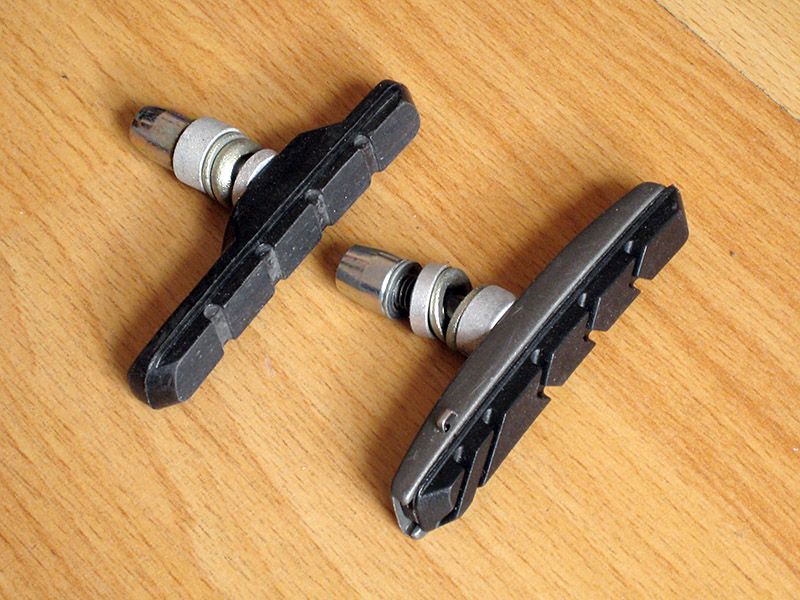
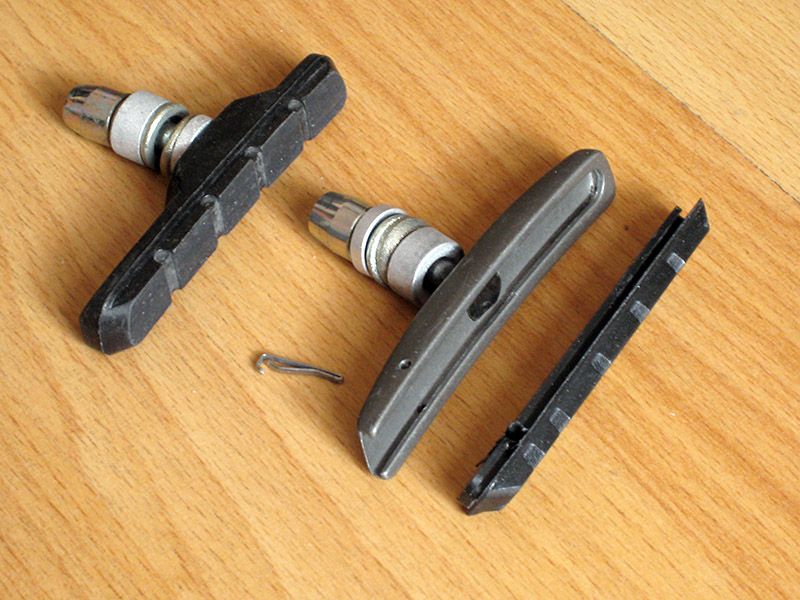
The difference in performance between cartridge pads and standard block pads is marginal, but it's the other things that give cartridge pads a slight advantage:
1) Replacing worn pads does not require resetting the whole brake block alignment against the rim - it just requires adding cable slack via the lever adjuster, unhooking the noodle, and sliding in fresh pads;
2) For the same given pad contact area and compound type, cartridge pads are generally lighter in weight than their block counterparts (typically 5-8g). Block pads are made by molding around metal inserts which accounts for the weight.
3) Cartridge pads look nicer, especially if you get shiny metal ones.
OP, I don't know if you've seen the self filmed documentary by Mark Beaumont (I think) about his bike tour from one end of the Americas to the other. His trials and tribulations highlighted the fact that, if your bike is built using exotic parts that are not easily field serviceable and for which replacements are difficult to come by in remote areas, you are going to struggle with your journey.
By exotic parts, I mean:
a) External type BB;
b) Proprietary headsets and/or bearings;
c) Proprietary wheels with straight pull spokes or with unusual spoke lengths;
etc.
Have a gander at Mark Beaumont's film to see what else you can learn from it.0 -
Thank you very much bikeaholic. that's cleared it up, understand now.
I've been reading a few long tour books but have not started Marks ones yet (I've purchased it), will get onto it asap.
I agree completely, I want to use as durable parts as possible whilst still focusing on maximum availability. This was the reason I recently changed from 700c to 26 and i'm glad I did.
Going back to the deore brakes, on my tiagra road bike I can control the 'balance' of getting the left/right pads to hit at same time by manually moving the 'arms' and then tightening the bolt. I notice on the Deore the 'swing' is controlled by the tension put on the bracing metal pole which is set by screws either side - is that right?
Thanks,0 -
id run cartridge just cos carrying spares wont take up as much room and are a much faster change, one r clip and your done. much better if your touring.0
-
Thank you, much appreciated,
Would it be possible to just change the brake mech from the current deore to the same on my road bike (tiagra) - I ask as I prefer the tweak adjusts on the tiagra?
Thanks,0 -
Probably not easily as they mount differently.I don't do smileys.
There is no secret ingredient - Kung Fu Panda
London Calling on Facebook
Parktools0 -
Bike-Rich wrote:...
Going back to the deore brakes, on my tiagra road bike I can control the 'balance' of getting the left/right pads to hit at same time by manually moving the 'arms' and then tightening the bolt. I notice on the Deore the 'swing' is controlled by the tension put on the bracing metal pole which is set by screws either side - is that right?
Thanks,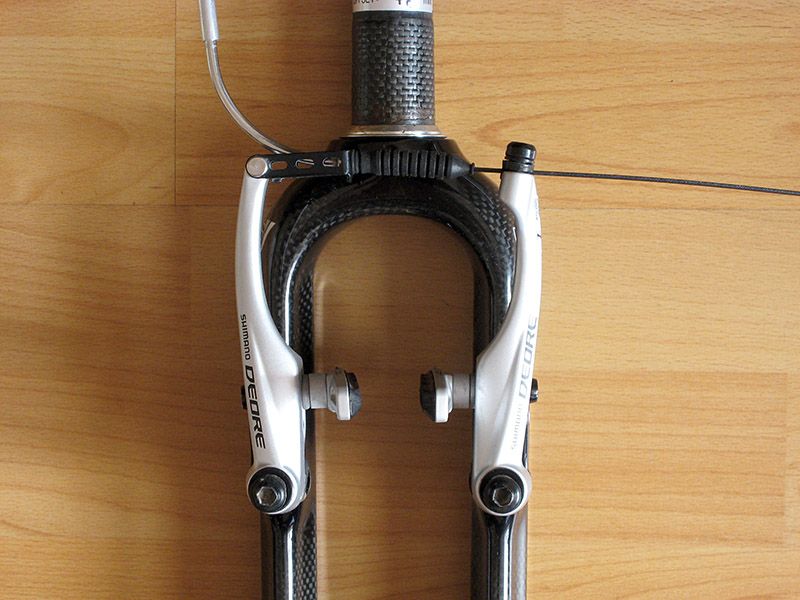
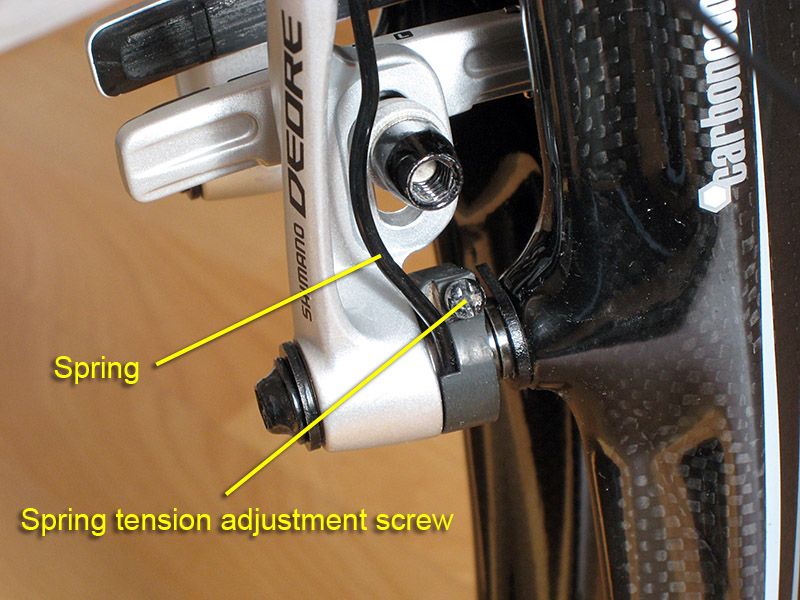
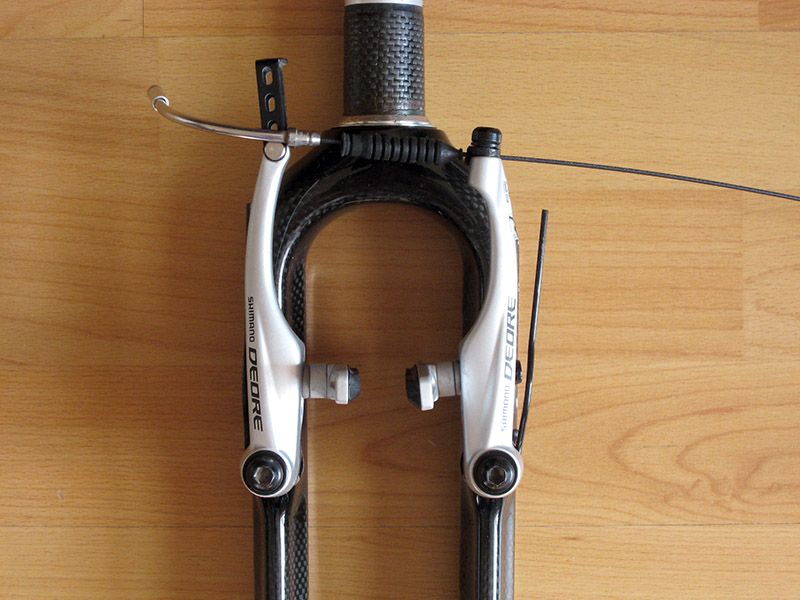
Above is a Shimano Deore front v-brake that I've temporarily setup to illustrate how to centralise the pads onto the rim.
The spring tension adjustment screws allow fine tuning when centralising the pads. If the adjustment screws have little to no effect, then you can unhook the spring(s) and bend them outwards to increase their springyness.
The spring tension adjustment screws make the spring stronger if you turn the screw inwards, and weaker if you turn them outwards.
If the brake is pulling to the right so that the left pad is rubbing onto the rim, then you can either make the LH spring stronger, or make the RH spring weaker, or a combination of both.
The procedure for centralising the pads is as follows:
(1) Lift the bike and spin the wheel to gauge the amount of tension adjustment needed. The reason for spinning the wheel is to account for any buckles in the rim;
(2) Squeeze and hold the brake lever so that the pads are very close to the rim (note, the wheel is still spinning at this point). If one side touches, then centralise by making that side's spring stronger (or make the other side weaker);
(3) Repeat step 1 and 2 to make the gap inbetween the rim and the pads smaller and smaller until the pads lightly touch on each side.
When centralising, ignore the movement of the caliper arms and just concentrate on the movment of the pads. The arm with the cable clamp bolt will move more before both pads touch the rim.0 -
Fantastic post, very grateful - thank you.
Just set the brakes up and they are much better now.bikaholic wrote:When centralising, ignore the movement of the caliper arms and just concentrate on the movment of the pads. The arm with the cable clamp bolt will move more before both pads touch the rim.
This was the mistake I was making, I was looking for the same amount of movement in each arm rather then the pads!
Would you say it is best to put both screws fully in and then work them out?0 -
Turning both screws in would increase lever effort, which can negate the effects of friction in the cables.
It does not matter if you turn both screws in before centering since you would be approaching a similar desirable outcome but just by a different route.0 -
Thanks again,
Looking to get some replacement 72mm holders for the pads, prefer the grub screw-holder type rather then the pin (don't want to carry pliers with me). Any suggestions?0 -
Any advice on above question much appreciated.
Thanks,0

